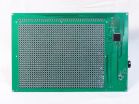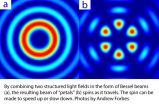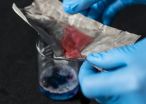A camera that powers itself!
Columbia Engineering professor invents a video camera that runs without a battery
2015-04-15
(Press-News.org) New York, NY--April 15, 2015--A research team led by Shree K. Nayar, T.C. Chang Professor of Computer Science at Columbia Engineering, has invented a prototype video camera that is the first to be fully self-powered--it can produce an image each second, indefinitely, of a well-lit indoor scene. They designed a pixel that can not only measure incident light but also convert the incident light into electric power. The team is presenting its work at the International Conference on Computational Photography at Rice University in Houston, April 24 to 26.
"We are in the middle of a digital imaging revolution," says Nayar, who directs the Computer Vision Laboratory at Columbia Engineering. He notes that in the last year alone, approximately two billion cameras of various types were sold worldwide. "I think we have just seen the tip of the iceberg. Digital imaging is expected to enable many emerging fields including wearable devices, sensor networks, smart environments, personalized medicine, and the Internet of Things. A camera that can function as an untethered device forever--without any external power supply--would be incredibly useful."
A leading researcher in computational imaging, Nayar realized that although digital cameras and solar panels have different purposes - one measures light while the other converts light to power - both are constructed from essentially the same components. At the heart of any digital camera is an image sensor, a chip with millions of pixels. The key enabling device in a pixel is the photodiode, which produces an electric current when exposed to light. This mechanism enables each pixel to measure the intensity of light falling on it. The same photodiode is also used in solar panels to convert incident light to electric power. The photodiode in a camera pixel is used in the photoconductive mode, while in a solar cell it is used in the photovoltaic model.
Nayar, working with research engineer Daniel Sims BS'14 and consultant Mikhail Fridberg of ADSP Consulting, used off-the-shelf components to fabricate an image sensor with 30x40 pixels. In his prototype camera, which is housed in a 3D printed body, each pixel's photodiode is always operated in the photovoltaic mode.
The pixel design is very simple, and uses just two transistors. During each image capture cycle, the pixels are used first to record and read out the image and then to harvest energy and charge the sensor's power supply--the image sensor continuously toggles between image capture and power harvesting modes. When the camera is not used to capture images, it can be used to generate power for other devices, such as a phone or a watch.
Nayar notes that the image sensor could use a rechargeable battery and charge it via its harvesting capability: "But we took an extreme approach to demonstrate that the sensor is indeed truly self-powered and used just a capacitor to store the harvested energy."
"A few different designs for image sensors that can harvest energy have been proposed in the past. However, our prototype is the first demonstration of a fully self-powered video camera," he continues. "And, even though we've used off-the-shelf components to demonstrate our design, our sensor architecture easily lends itself to a compact solid-state imaging chip. We believe our results are a significant step forward in developing an entirely new generation of cameras that can function for a very long duration--ideally, forever--without being externally powered."
INFORMATION:
The research was funded by Office of Naval Research.
Details: http://www.cs.columbia.edu/CAVE/projects/self_powered_camera/
ELSE PRESS RELEASES FROM THIS DATE:
2015-04-15
UNIVERSITY OF CALIFORNIA, BERKELEY'S HAAS SCHOOL OF BUSINESS -CEOs make a lot of money from incentive pay tied to stock performance. Although such schemes help align executives' interests with shareholders, they are not necessarily the best schemes as compared to schemes that rely on trust between board and executives.
"Ironically, the necessary trust is easier to establish when the alternative of using stock-based pay is less powerful. Our research found that government-imposed limits on contingent compensation make stock-based pay a worse alternative, facilitating superior ...
2015-04-15
Thermoluminescence is used extensively in archaeology and the earth sciences to date artefacts and rocks. When exposed to radiation quartz, a material found in nature, emits light proportional to the energy it absorbs. Replicating the very low dose of background radiation from natural sources present in quartz is a key precondition for precise and accurate dating results. Italian scientists have now developed a method to control the accuracy of the dose calibrations delivered to the samples during laboratory irradiation with heavy particles, replicating natural radiation ...
2015-04-15
According to the World Health Organization, breast cancer is the most common cancer in women both in the developed and less developed world, and in the long term the scientists hope that the new method will lead to better prevention and early treatment of the disease.
"The method is better than mammography, which can only be used when the disease has already occurred. It is not perfect, but it is truly amazing that we can predict breast cancer years into the future," said Rasmus Bro, a professor of chemometrics in the Department of Food Science at University of Copenhagen. ...
2015-04-15
Today it is not possible to predict spreading from malignant melanomas. Melanoma metastases are furthermore extremely difficult to eliminate as traditional treatment such as chemotherapy and radiotherapy is mostly ineffective. Only ten per cent of the patients survive once they reach an advanced stage with distant metastases.
New research now demonstrates that the presence of the protein megalin in a malignant melanoma is an indicator of cancer cells that are particularly aggressive. The protein improves the ability of the cancer cells to divide and to survive. Accordingly, ...
2015-04-15
COLLEGE STATION, TX - The bedding plants sold in retail outlets are typically grown in greenhouse production environments where professionals can monitor irrigation, light, and temperature. When the greenhouse-grown plants reach the retail market, however, they are often subjected to a range of less-than-ideal light levels, temperatures, and irrigation schedules that can be detrimental to plant quality and vigor. Researchers are looking for ways to increase bedding plants' shelf life to offset the negative impacts of postharvest handling.
A new research study of the popular ...
2015-04-15
Light must travel in a straight line and at a constant speed, or so the laws of nature suggest. Now, researchers at the University of the Witwatersrand in Johannesburg have demonstrated that laser light traveling along a helical path through space, can accelerate and decelerate as it spins into the distance.
This is the first time that angular acceleration has been observed with light, and is therefore likely to lead to new applications using these structured light fields.
The results are contained in a research paper by Professor Andrew Forbes from the Wits School of ...
2015-04-15
E-cigarettes are not without health risks for people who vape or for bystanders. This is one of the conclusions from a new risk assessment report from the Norwegian Institute of Public Health (NIPH).
The report has only considered e-cigarettes with nicotine since there has been very little research about e-cigarettes without nicotine.
In summary
Since e-cigarettes supply nicotine in the same quantities as cigarette smoking, the same harmful effects from nicotine can be expected.
The vapour from e-cigarettes contains so much nicotine that bystanders can ingest ...
2015-04-15
Health surveys may underestimate the number of poisonings in the United States by 60 percent to 90 percent, according to a report in the journal Clinical Toxicology by University of Illinois at Chicago researchers.
As of 2009, poisonings became the leading cause of fatal injury in the U.S., surpassing transportation-related deaths and gun-related deaths.
The researchers analyzed hospital billing records, patient demographics, exposure information, and outcomes for Illinois hospital visits related to poisonings in 2010. They also looked at poisoning incidence data from ...
2015-04-15
AMES, Iowa - It was a discovery that changed what researchers knew about the hunting techniques of chimpanzees. In 2007, Jill Pruetz first reported savanna chimps at her research site in Fongoli, Senegal, were using tools to hunt prey. That alone was significant, but what also stood out to Pruetz was the fact that female chimps were the ones predominantly hunting with tools.
It was a point some dismissed or criticized because of the small sample size, but the finding motivated the Iowa State University anthropology professor to learn more. In the years following, Pruetz ...
2015-04-15
COLUMBUS, Ohio--The unassuming piece of stainless steel mesh in a lab at The Ohio State University doesn't look like a very big deal, but it could make a big difference for future environmental cleanups.
Water passes through the mesh but oil doesn't, thanks to a nearly invisible oil-repelling coating on its surface.
In tests, researchers mixed water with oil and poured the mixture onto the mesh. The water filtered through the mesh to land in a beaker below. The oil collected on top of the mesh, and rolled off easily into a separate beaker when the mesh was tilted.
The ...
LAST 30 PRESS RELEASES:
[Press-News.org] A camera that powers itself!
Columbia Engineering professor invents a video camera that runs without a battery





